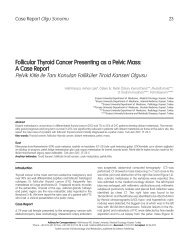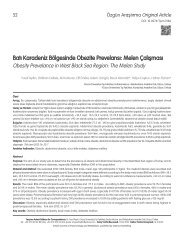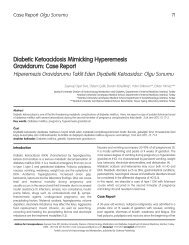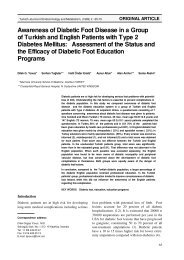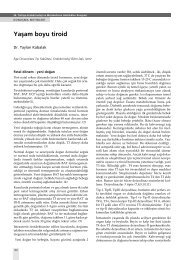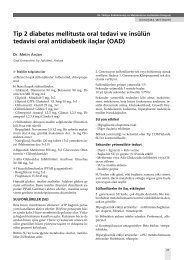Pheochromocytoma in Association With Graves' Disease; A Case ...
Pheochromocytoma in Association With Graves' Disease; A Case ...
Pheochromocytoma in Association With Graves' Disease; A Case ...
You also want an ePaper? Increase the reach of your titles
YUMPU automatically turns print PDFs into web optimized ePapers that Google loves.
Turkish Journal of Endocr<strong>in</strong>ology and Metabolism, (1999)4: 185-187<br />
CASE REPORT<br />
<strong>Pheochromocytoma</strong> <strong>in</strong> <strong>Association</strong> <strong>With</strong> <strong>Graves'</strong><br />
<strong>Disease</strong>; A <strong>Case</strong> Report<br />
Erdem Okay*<br />
Berr<strong>in</strong> Çet<strong>in</strong>arslan**<br />
University, Faculty of Kocaeli, Schoo! of Medic<strong>in</strong>e Kocaeli, Turkey<br />
" Assistant Professor, Department of General Surgery<br />
" Associate Professor, Department of Endocr<strong>in</strong>ology<br />
Introduction<br />
<strong>Pheochromocytoma</strong> and thyrotoxicosis are two<br />
entities that may mimic many similar symplo'ms<br />
and signs alİke; therefore, öne must be careful<br />
<strong>in</strong> the differential diagnosis. <strong>in</strong> the rare cases<br />
where both entities co<strong>in</strong>cide, a meticulous history,<br />
physical exam<strong>in</strong>ation and detailed laboralory<br />
<strong>in</strong>vestigation are needed to make a precise<br />
diagnosis.<br />
The . possible <strong>in</strong>duction of thyrotoxicosis by<br />
catecholam<strong>in</strong>es <strong>in</strong> the associatîon of pheochromocytoma<br />
and <strong>Graves'</strong> disease, is under dispute.<br />
Correspondence address:<br />
Erdem Okay<br />
Kocaeli Tıp Fakültesi<br />
Genel Cerrahi Anabilİm Dalı<br />
Sopalı Çiftliği, Der<strong>in</strong>ce, İzmit<br />
41900 Kocaeli, Türkiye<br />
We have presented a case with pheochromocytoma and thyrotoxicosis. She was<br />
admitted on the grounds of weight loss, palpitation, svveat<strong>in</strong>g and headache, She<br />
described numerous attacks of flush<strong>in</strong>g and palpitation. On physical exam<strong>in</strong>ation her<br />
thyroid gland was diffusely enlarged and she had a mild tremor. Laboratory<br />
<strong>in</strong>vestigations were <strong>in</strong> accordance with bolh pheochromocytoma and <strong>Graves'</strong><br />
disease. Abdom<strong>in</strong>al ultrasonography and computerized tomography scan revealed a<br />
mass located <strong>in</strong> the right adrenal gland. Metaiodobenzylguanid<strong>in</strong>e sc<strong>in</strong>tiscan<br />
confirmed the diagnosis. The patienl had preoperative medical therapy for both<br />
<strong>Graves'</strong> disease and pheochromocytoma. After surgical removal of the tümör and<br />
right adrenal gland, the patient was euthyroid without any medical therapy dur<strong>in</strong>g the<br />
follow-up period. <strong>in</strong> this case we wanted to po<strong>in</strong>t out the possible role of<br />
catecholam<strong>in</strong>es <strong>in</strong> Ihe physiopathology of hyperthyroidism and <strong>Graves'</strong> disease.<br />
Keywords: <strong>Pheochromocytoma</strong>, Hyperthyroidism, <strong>Graves'</strong> disease<br />
<strong>Case</strong> report<br />
A Forty-five-year old female patient attended the<br />
endocr<strong>in</strong>ology outpatient cl<strong>in</strong>ic <strong>in</strong> July 1997 with<br />
compla<strong>in</strong>ts of weight loss, palpitation, sweat<strong>in</strong>g<br />
and headache. She described bouts of hypertension<br />
crisis accompanied by flush<strong>in</strong>g and palpitation.<br />
Her blood pressure was 120/80 mmHg, heartbeat<br />
was 100/m<strong>in</strong>. and rhythmic. Her sk<strong>in</strong> was wet and<br />
th<strong>in</strong> with periorbital edema. We observed a mild<br />
tremor. Her thyroid gland was consİdered as<br />
diffuse, grade l b. Her laboratory f<strong>in</strong>d<strong>in</strong>gs were as<br />
follows; free T3: 27,13 pg/ mi (N: 1.45-3.48), free<br />
T4; 6 ng/dl (N: 0.71-1.85), hTSH: 0.09 ulU/ml (N:<br />
0.49-4.67), anti-M and anti-Tg were posİtive. We<br />
started 300 mg/day propylthiouracil with the<br />
diagnosis of diffuse toxic goilre.<br />
Dur<strong>in</strong>g her stay she had hypertension bouts ris<strong>in</strong>g<br />
up to 200/110 mmHg. Abdom<strong>in</strong>al sonography<br />
revealed a mass 31 x 25 mm <strong>in</strong> size located <strong>in</strong> the<br />
right adrenal gland. This mass was also present <strong>in</strong><br />
185
CASE REPORT<br />
abdom<strong>in</strong>al CT. 24 hour ur<strong>in</strong>e analysis showed;<br />
VMA: 13.9 mg/day (N: 1-10), metanephr<strong>in</strong>: 2.36<br />
mg/day (N; 0-1). The mass was thought to be a<br />
171<br />
pheochromocytoma. The patient underwent I ~-<br />
metaiodobenzylguanid<strong>in</strong> s<strong>in</strong>tiscan to confirm the<br />
diagnosis and to check the presence of another<br />
localization of the tümör. There was a tümör only<br />
-on the right side (figüre 1). We could not f<strong>in</strong>d any<br />
sign of an accompany<strong>in</strong>g MEN2a ör MEN2b<br />
syndrome. We started 4 mg/day prazosîn to<br />
control the hypertension bouts and to prepare the<br />
patient for surgery.<br />
The patient was taken to the operation room six<br />
weeks after the start of medical treatment <strong>in</strong> a clİnically<br />
eutyhyroid state. The mass was approached<br />
through a right subcostal <strong>in</strong>cision. Blood prcssure<br />
reached a level of 260/120 mmHg when the gland<br />
was palpated, which was normalized aga<strong>in</strong> with<br />
phentolam<strong>in</strong>e. Through meticulous work, the gland<br />
was dissected, the ve<strong>in</strong> Hgated and totally excised.<br />
We did not bbserve any complications durîng the<br />
postoperative period. Histopathological study confirmed<br />
the lesion as a pheochromocytoma. There<br />
was no <strong>in</strong>vasion of the vessels ör the capsule.<br />
Dur<strong>in</strong>g the follow-up period, the patient's blood<br />
pressure was with<strong>in</strong> the normal range aftcr öne, six<br />
and 12 months, with no bouts of hypertension. She<br />
was also euthyroid without any medicatîon.<br />
Discussion<br />
<strong>Pheochromocytoma</strong> is an adrenal medullary tümör<br />
orig<strong>in</strong>at<strong>in</strong>g from the chromaff<strong>in</strong> cells located <strong>in</strong> the<br />
sympathic peripheral nerves. The symptoms<br />
186<br />
presented <strong>in</strong> this entity are due to hypcrexcretion<br />
of cp<strong>in</strong>ephr<strong>in</strong>e ör norep<strong>in</strong>cphr<strong>in</strong>e (1). Symptoms<br />
connectcd mostly with sympathic tonus conccrn<strong>in</strong>g<br />
thyrotoxicosis are due to the dircct effect of<br />
thyroid hormones on varİous tissues (2).<br />
it is well known that pheochromocytoma İs accompanied<br />
by medullary thyroid mahgnancy <strong>in</strong> MEN<br />
syndromcs. it has been stated that autoİmmune<br />
thyroid diseases may also accompany pheochromocytoma.<br />
Becker el al. have shovvn that f i ve out<br />
of 36 cases with pheochromocytonıa prcscnled<br />
with thyroid disea.se other Ihan medullary carc<strong>in</strong>oma<br />
and <strong>in</strong> three of thesc (8,3 %) mey observed<br />
abnormal thyroid functions (4). Braverman and<br />
Sullivan <strong>in</strong> 1969 and Dimova and Kiscleva <strong>in</strong> 1987<br />
presented cases with pheochromocytoma and<br />
accompany<strong>in</strong>g diffuse toxic goitre (5,6). Snow and<br />
Burton presented a case <strong>in</strong> 1976 rcvcal<strong>in</strong>g a<br />
postmortem pheochromocytoma opcrated for<br />
hyperthyroidism, the previous symptoms depcnd<strong>in</strong>g<br />
on the turnor (7). Barlholomci c: al. have<br />
po<strong>in</strong>ted out a case with pheochromocytoma<br />
accompany<strong>in</strong>g autoimmune hypothyroidism (8).<br />
Our patient has attended with signs and symptoms<br />
rnimick<strong>in</strong>g both diseases. Even though our primary<br />
approach was towards thyrotoxicosis, bouts of<br />
hypertension has <strong>in</strong>tensifİed our attcnüon to<br />
pheochromocytoma.<br />
The thyroid gland İs enlarged İn 6 % of the cases<br />
vvith pheochromocytoma. II has been shown that<br />
experimental <strong>in</strong>fusion of norepİnehr<strong>in</strong> may İcad to<br />
such cıılargement (9, 10). This mechanism and its<br />
action on human goitre etİology has not yet been<br />
clarified. it İs known that catecholam<strong>in</strong>es stimulate<br />
thyrox<strong>in</strong>, calciton<strong>in</strong>, PTH and gastr<strong>in</strong> secretion via<br />
beta receptors (11). it is also been stated that<br />
catecholam<strong>in</strong>es aggravate immunologic deficiency<br />
lead<strong>in</strong>g to <strong>Graves'</strong> disease (10). From this po<strong>in</strong>t of<br />
view it can be postulated that pheochromocytoma<br />
may share a part <strong>in</strong> the physiopathology and<br />
exacerbation of <strong>Graves'</strong> disease. The remisson of<br />
<strong>Graves'</strong>disease follow<strong>in</strong>g surgical ireatment of<br />
pheochromocytoma <strong>in</strong> our patient supports our<br />
thesis.<br />
On the contrary, Harrison reported patients with<br />
pheochromocytoma whose serum prote<strong>in</strong> bound<br />
iod<strong>in</strong>e, rate of release and uptake of I ' , and rate
CASE REPORT<br />
of clearence of labelled T, ör T 4 were with<strong>in</strong> ihe<br />
normal range, thus deny<strong>in</strong>g ihe eflect of phcochromocytoma<br />
<strong>in</strong> these cases (12).<br />
The diagnosis of pheochromocytoma is difficult <strong>in</strong><br />
cases shar<strong>in</strong>g symptoms of thyrotoxicosis, where<br />
both diseases may be operat<strong>in</strong>g at the same time.<br />
The role of catecholam<strong>in</strong>es İn the physiopathology<br />
of hyperthyroidi.sm is stili under dispute.<br />
References<br />
1. Landsbcrg L.,Young JB. Catecholam<strong>in</strong>cs and (he adrenal<br />
mcdulla. Editors: Wilson JD, Poster D W. Williams<br />
Textbook of Endocr<strong>in</strong>ology, 8. Edition Philadeiphia, W.<br />
B. Saunders Company, 621-705, 1992.<br />
2. Greenspan FS. Hyperthyroidism & Thyrotoxicosis.<br />
Editors: Greenspan FS, Slrewler GJ. Basic & Cl<strong>in</strong>ical<br />
Endocr<strong>in</strong>olügy, 5. Edition, Stamlbrd, Applcton & Langc,<br />
233-242, 1997.<br />
3. Larsen PR, Ingbiir SH. Thyrotoxicosis. Bdilors: Wj]son JD,<br />
Fostcr DW. Wi!]iaıns Texibook of Endocr<strong>in</strong>ology, 8. Edition<br />
Philadeiphia, W. B. Saunders Company, 414-445, 1992.<br />
4. Becker CE, Rosen SW, Engel man K. <strong>Pheochromocytoma</strong><br />
and hyporcsponsivencss to thyrotrop<strong>in</strong> <strong>in</strong> a 46XYmalc<br />
with t'eatures ol' Ihe Tıırncr pheotype. AHU lntcnı Mal, 70:<br />
325-328, 1969.<br />
5. Braverman LE, SuIIivan R M. Anothcr polyendocr<strong>in</strong>c<br />
disorder: phechromocytoma and diH'use loxic goiter.<br />
Hopk<strong>in</strong>sMedJ, 125: 331-335, 1969.<br />
6. Dimova MN Kiscleva TP Casc of comb<strong>in</strong>ed diffııse toxic<br />
goilcr and plıeochromocytoma. Probl Endokr<strong>in</strong>ol Mosk<br />
33:42-43, 1987.<br />
7. Snow MH, Burlon P. A case of associated thyro!oxicosîs<br />
and pheochromocytoma. A diagnostic problem. Postgrad<br />
52:28S-29[, 1976,<br />
8. Bartolomci C, Gianchccchi D, Chiavistelli P, Lcnzi R.<br />
<strong>Pheochromocytoma</strong> and autoimmune hypothyroidism.<br />
MittcrvaMed,S3: 485-486, 1992.<br />
9. Hcrman H, Momex R. Human Tumours Secrcl<strong>in</strong>g<br />
Catecholam<strong>in</strong>es. Oxt'ord, Pergamon Press 1964<br />
10. Pa.schkc R, Enger J, Harsch I, Usadel KH. Relapsc of<br />
Gravcs'discasc follovv<strong>in</strong>g developmcnl of a pheochromocytoma.<br />
Thyroid 2:203-206, 1992.<br />
1 1. Goldfien A. Hormoncs of Ihe adrenal medulla. Catecholam<strong>in</strong>es.<br />
Editors: Greenspan FS, Strewler GJ. Basic<br />
(Cl<strong>in</strong>ical Endocr<strong>in</strong>ology, 5. Edition, Stamford, Applcton<br />
&Langc, 382-39 1, 1997<br />
12. Harri.son TS Adrenal rnedullary and ihyroid rclalionships.<br />
ical Keviews, 44: 1 6 1 - 1 67, 1 964.<br />
187




